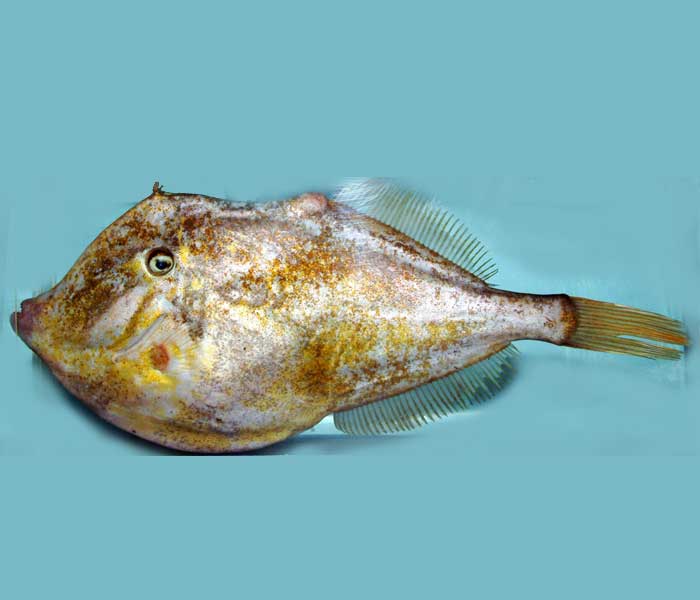
Aluterus schoepfii (SEFSC Pascagoula Laboratory; Collection of Brandi Noble, NOAA/NMFS/SEFSC )
Superregnum : Eukaryota
Regnum: Animalia
Subregnum: Eumetazoa
Cladus: Bilateria
Cladus: Nephrozoa
Superphylum: Deuterostomia
Phylum: Chordata
Cladus: Craniata
Subphylum: Vertebrata
Infraphylum: Gnathostomata
Megaclassis: Osteichthyes
Superclassis/Classis: Actinopterygii
Classis/Subclassis: Actinopteri
Subclassis/Infraclassis: Neopterygii
Infraclassis: Teleostei
Megacohors: Osteoglossocephalai
Supercohors: Clupeocephala
Cohors: Euteleosteomorpha
Subcohors: Neoteleostei
Infracohors: Eurypterygia
Sectio: Ctenosquamata
Subsectio: Acanthomorphata
Divisio/Superordo: Acanthopterygii
Subdivisio: Percomorphaceae
Series: Eupercaria
Ordo: Tetraodontiformes
Familia: Monacanthidae
Genus: Aluterus
Species: A. schoepfii
Aluterus schoepfii, the orange filefish, is a species of fish in the family Monacanthidae. The species can also be listed under the family Balistidae. They can reach a maximum size of 62 centimetres (24 in) although they are common to 40 centimetres (16 in).[2]
Characteristics
Orange filefish can be distinguished by the presence of 2 dorsal spines and 32-29 dorsal soft rays. They do not have anal spines but have 35–41 anal soft rays. The pelvic terminus is absent, the body has numerous small round orange or orange-yellow spots, and the lips are often blackish.[3]
Distribution
Orange filefish are distributed along the Western Atlantic. This includes Nova Scotia, Bermuda, and the northern Gulf of Mexico to Brazil. Distributions along the Eastern Atlantic include Cape Blanc and Mauritania to Angola.[3]
Environment
Orange filefish are benthic fish distributed in a depth range of 3 to 900 metres (10 to 2,953 ft). They are subtropical, found between 46°N and 33°S latitudes.[3] [4]
Habitat
These fish are usually found solitary or in pairs over sea bottoms with sea grass, sand, or mud. Juveniles can be found associated with floating Sargassum.[3]
Feeding
Orange filefish feed on a variety of aquatic vegetation, including sea grasses and algae.[3]
Importance to humans
Orange filefish are considered trash fish and rarely consumed by humans. In Brazil these fish are traded as aquarium fish. These fish contain a poison (ciguatoxin) in their triggers that can be potentially threatening to humans who come in contact with them.[3]
Similar species
The dotterel filefish is similar to the orange filefish, although the dotterel filefish has a longer tail fin and no orange spots along the body. The orange filefish differs from other triggerfishes by having only 2 dorsal spines.[2]
References
Matsuura, K., Robertson, R. & Tyler, J. (2015). Aluterus schoepfii. The IUCN Red List of Threatened Species doi:10.2305/IUCN.UK.2015-4.RLTS.T16404974A16510262.en
“Orange Filefish: Aluterus schoepfii.” Texas A&M University Galveston.
Luna, Susan M. “Aluterus schoepfii.” FishBase
Bailly, N. (2014). &id=159490 Aluterus schoepfii (Walbaum, 1792). In: Froese, R. and D. Pauly. Editors. (2014) FishBase.
Retrieved from "http://en.wikipedia.org/"
All text is available under the terms of the GNU Free Documentation License

